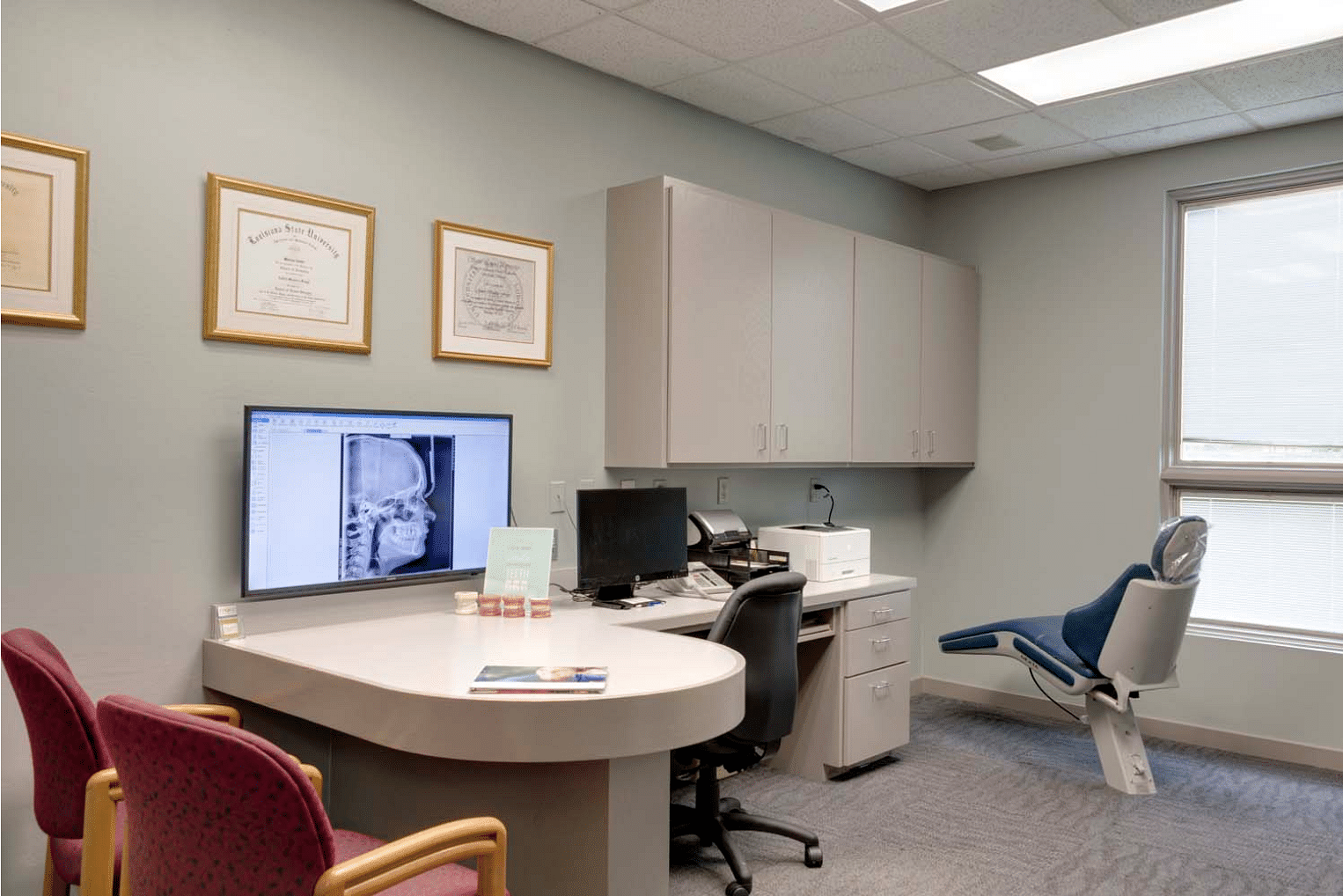For Adults
Despite the belief by some that braces are just for teens and children, approximately 25% of our patients are adults. Many adults choose orthodontic treatment because they understand the importance of being proactive in maintaining their health and they want to feel more confident about their smile. Common reasons for adult orthodontic treatment:
- A bad bite, or malocclusion, causing teeth to fit and function incorrectly
- Crowding or spacing in teeth can cause tooth decay or gum disease
- Abnormal pain, or pressure, in the jaw that is caused by teeth not being aligned
- Excessive wear due to malocclusion
- A healthier mouth and a more confident smile
If you are an adult considering orthodontic treatment but are wary of choosing to use traditional metal braces, talk to Dr. Frugé about the possibility of using clear brackets or Invisalign for a less noticeable method of treatment.
For Children
The American Association of Orthodontics recommends that children make their first visit to the orthodontist around age seven. By this time, most children have a mix of baby teeth and adult teeth, making it easier for Dr. Frugé to diagnose and correct tooth and jaw problems early. Early interceptive treatment allows Dr. Frugé to:
- Correct and guide the growth of your child’s jaw to help with function and facial esthetics
- Create more room for crowded teeth with arch development
- Help the patient avoid the need to extract permanent teeth later in life
- Correct effects of thumb sucking and help improve minor speech problems
- Reduce the risk of trauma to protruding upper front teeth
- Expand the upper jaw to correct crossbites and increase upper airway volume reducing the risk of sleep apnea
Frequently Asked Questions
Orthodontics (also referred to as dentofacial orthopedics) is a specialized form of dentistry, focusing on the diagnosis, prevention, and treatment of dental and facial abnormalities.
An orthodontist is a dental specialist who has received two to three years of additional training and experience. Your orthodontist is able to straighten teeth, correct misaligned jaw structure, and improve the function of your smile.
If you want to improve the look and feel of your smile, then any age can be a great age to see the orthodontist. The American Association of Orthodontists recommends that children first visit an orthodontist around the age of seven; however, orthodontic treatment is not exclusive to children and teens, with about one in every five orthodontic patients being over the age of 21. Whether you’re considering treatment for yourself, or for a child, any time is a good time to visit the orthodontist.
- ALWAYS remember to brush your teeth after every meal and floss at least once a day.
- Make sure to use toothpaste that contains fluoride and ask your orthodontist or family dentist if you need a fluoride rinse. This will help prevent cavities!
- If you take out your retainer to eat, brush your teeth, floss, and remember to keep it safe in its container so that it does not get lost or broken.
- Keep your retainer clean too by brushing it gently with a toothbrush and toothpaste. You may also soak it in denture cleaner as instructed by your orthodontist. Do not put your retainer in boiling water or in the dishwasher.
- During your treatment, try to avoid foods with a lot of sugar (sugar increases the amount of bacteria that grows in your mouth causing more plaque and possibly cavities).
- Avoid sticky and chewy foods (caramel, chewing gum, gummy bears), hard foods (hard candy, nuts, ice cubes) or any foods that could possibly get stuck in your braces (corn on the cob, soft bagels, ribs, taffy, etc).
- Be sure to schedule your routine checkups with your family dentist. It is recommended that you continue to visit the dentist every six months.
Braces are used by your orthodontist to help you improve the look and feel of your smile. There are several different types of braces to choose from, including:
- Clear braces
- Ceramic braces
- Self-ligating braces
- Invisible braces
- Traditional metal braces
The amount of time spent in braces can vary depending on the individual patient, as every smile responds differently to treatment. Treatment times can take anywhere between 6 and 30 months; however, most standard treatments take about 22 months.
Braces do not often hurt; however, you may feel a small amount of discomfort for a couple days as your teeth, gums, cheeks, and mouth gets used to your new braces.
With braces, you should brush your teeth at least three times a day to keep your teeth, gums, and mouth healthy and clean. Brushing regularly will help remove any food that may be caught between the braces. You should also floss daily to get in between your braces where your brush isn’t able to reach. Your orthodontist can show you how to properly brush and floss once your braces are placed.
Yes! In fact, it’s even more important that patients receiving orthodontic treatment visit their dentist regularly. With braces, food may be caught in places that your toothbrush can’t reach. This causes bacteria to build up and can lead to cavities, gingivitis, and gum disease. Your dentist will work closely with your orthodontist to make sure that your teeth stay clean and healthy while wearing braces.
Playing an instrument or a contact sport may require some adjustment when you first get your braces, but wearing braces will not stop you from participating in any of your school activities. If you play a contact sport, it is recommended that you wear a mouthguard to protect your braces or appliance.
Simply call our practice! Our front desk staff will be happy to help schedule your next appointment at your convenience. If you are a new patient or have been referred to our practice, please let us know, and we will provide you with all of the information you need.









Follow Us On Social